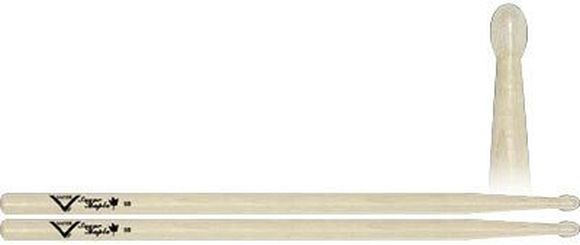3. Materials
wood
Over 90% of drumsticks, are made from wood. You should pay attention to the quality of the wood. Usual woods are Hickory, oak and maple. The wood type has a large influence on the sound, the balance and the longevity of the Drumsticks. The grain has to run straight from head to end. A good technique is to take the sticks into your hands and play them on an even, firm surface. Do they feel the same, do they sound the same, how is the feeling? If the sticks sound alike, you can also assume the weight is equal. A good test is to roll the stick. This way you easily see whether it is straight or not.
Nowadays, because of modern manufacturing processes one can assume all major manufacturers supply perfect pairs.
On the question which wood is best there is no clear answer. It depends on the taste of the Drummer and the style of the music. Mostly used is Hickory, oak and maple. Hornbeam sticks are also available on the market.
Hickory
Hickory is an American hardwood. The density and hardness are a bit less then oak. Hickory is a first-class shock absorber. This makes the play fatigue-free and is easy on the wrists. Hickory has a very good weight to strength ratio and a lot of Drummers prefer sticks made of this material.
Oak (Japanese oak, Shira Kashi)
oak is about 10% more heavy than Hickory. It is a harder wood and has therefore a longer life span. Oak can be played harder than all other woods. A stick of same weight is thinner in oak. Oak does not wear out by stronger cymbal play and also does not break from Rim shots as easily.
Maple
Maple is about 10% lighter than Hickory. This way a thicker stick can be achieved with the same weight. Many Drummers select maple exactly for this reason: A relatively thick stick with little weight. Maple sticks are taken mainly for light, fast play In quieter situations. I.e. practice. Maple is not as durable as oak or Hickory.
Hornbeam
A European hardwood that in its characteristics, such as tenacity and hardness, exceeds the European oak. It is best compared with the Japanese Shira Kashi.
Beside these woods there are some exotic types on offer. A general rule is hard to make , they concern "specialists" .. As already said - simply try them out a few times.
Surfaces
Drumsticks come lacquered and unlacquered. The lacquer has the task of protecting the surface of the wood. Its main purpose though is keeping the humidity levels (or rather degree of dryness) of the wood constant. Water absorption may warp the stick. Too much humidity gives it a rubber-like feel. Too little makes it brittle and the stick will break easily. There are also some coloured series, mostly white. This looks particularly good during a gig, especially if you can do some stick-tricks.
Unlacquered sticks are useful If hand sweat is a problem. During a long concert for example, painted sticks may fly out of your hands. However, there are also sticks with a rubber coating at the handle end. Another possibility is to attach a special Tape.
Metal
Lars Ulrich (Metallica) made this material popular. Sticks from Aluminum are very durable. The manufacturing process makes it possible to produce a stick with extremely small tolerances, i.e. one is EXACTLY like the other one. The difference is less than 1%. The head can be unscrewed and exchanged. Several shapes are available. The weights are certainly in the upper range, which makes the stick popular in the Metal scene. A coat of urethane is necessary to prevent damage to drumheads and cymbals. The stress on the cymbals is however a genuine problem. With light cymbals aluminum sticks should be used with caution.
Carbon
Carbon fiber, a synthetic material, has a feel similar to Hickory. Carbon is characterized by higher durability compared to wood. The abrasion resistance is extremely high. It is sweat absorbent which means the sticks do not slip in damp hands i.e. sweaty palms. Carbon sticks are black, which makes them visually appealing.
Laminate
The sticks are, similar to plywood, built from several layers. In most cases they are made from veneer. The individual layers are made from a variety of woods and have therefore different characteristics. The result is a stick with excellent rebound, i.e. the stick jumps back easily.
They are a good choice for drum rolls. Laminate sticks are often multicoloured depending on the woods used in the layers.









